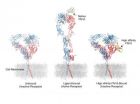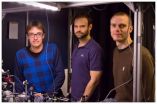(Press-News.org) Massachusetts General Hospital (MGH) investigators may have found a way to solve a problem that has plagued a group of drugs called ligand-mimicking integrin inhibitors, which have the potential to treat conditions ranging from heart attacks to cancer metastasis. In a Nature Structural & Molecular Biology paper receiving advance online publication, the researchers provide a structural basis for the design of new and safer integrin inhibitors.
Integrins are receptor proteins found on the surface of cells that determine whether or not cells adhere to adjacent cells and the surrounding extracellular matrix. Under normal circumstances, integrins only become activated – which allows them to bind to other cells or extracellular molecules – in response to specific signals from within the cell. If integrins become overactive, cells become too "sticky" – leading to clogged arteries, pathological inflammation, the excess tissue growth called fibrosis or the spread of cancer. Current drugs developed to inhibit integrin activation by mimicking the shape of ligands – the molecules that interact with receptors – have had unintended effects in some patients, and as a result only a handful have received FDA approval.
"Integrins have an intrinsic ability to shape-shift when they switch from an inactive to an active, adhesive state," explains M. Amin Arnaout, MD, director of the MGH Leukocyte Biology Program and the Inflammation and Structural Biology Program, senior author of the study. "Unfortunately, under some circumstances the integrin inhibitors that have been developed to date can inadventently induce this shape shifting, and use of these drugs have produced serious, sometimes fatal side effects such as excessive bleeding."
In their search for drugs that would not induce these complications, the MGH team focused on an extracellular matrix protein called fibronectin, which binds to an integrin called αvβ3. Their detailed structural analysis of the bond between αvβ3 and various forms of FN10, the fibronectin molecule that interacts with αvβ3, identified a high-affinity version of FN10 that binds more strongly than the common form without causing unintended receptor activation. This first report of the three-dimensional atomic structure of an integrin binding with a ligand-mimicking molecule that does not cause inadvertent activation could enable the design of a new generation of integrin inhibitors without the complications that have limited their application.
INFORMATION:
The co-lead authors of the Nature Structural & Molecular Biology paper are Johannes van Agthoven, PhD, and Jain-Ping Xiong, PhD, of the Structural Biology Program in the MGH Department of Medicine. Additional co-authors are Brian Adair, PhD, Structural Biology Program; José Luis Alonso PhD, and Xianliang Rui, PhD, Leukocyte Biology and Inflammation Program, MGH Medicine; and Simon Goodman, DPhil, Merck KGaA, Germany. Arnaout is a physician and chief emeritus of the Division of Nephrology in the MGH Department of Medicine and a professor of Medicine at Harvard Medical School. The study was supported by National Institute of Diabetes and Digestive and Kidney Diseases grants DK088327, DK096334 and DK007540.
Massachusetts General Hospital, founded in 1811, is the original and largest teaching hospital of Harvard Medical School. The MGH conducts the largest hospital-based research program in the United States, with an annual research budget of more than $775 million and major research centers in AIDS, cardiovascular research, cancer, computational and integrative biology, cutaneous biology, human genetics, medical imaging, neurodegenerative disorders, regenerative medicine, reproductive biology, systems biology, transplantation biology and photomedicine.
Mass. General study identifies path to safer drugs for heart disease, cancer
2014-03-23
ELSE PRESS RELEASES FROM THIS DATE:
Unavoidable disorder used to build nanolaser
2014-03-23
Researchers the world round are working to develop optical chips, where light can be controlled with nanostructures. These could be used for future circuits based on light (photons) instead of electron - that is photonics instead of electronics. But it has proved to be impossible to achieve perfect photonic nanostructures: they are inevitably a little bit imperfect. Now researchers at the Niels Bohr Institute in collaboration with DTU have discovered that imperfect nanostructures can offer entirely new functionalities. They have shown that imperfect optical chips can be ...
Could diamonds be a computer's best friend?
2014-03-23
COLUMBUS, Ohio—For the first time, physicists have demonstrated that information can flow through a diamond wire.
In the experiment, electrons did not flow through diamond as they do in traditional electronics; rather, they stayed in place and passed along a magnetic effect called "spin" to each other down the wire—like a row of sports spectators doing "the wave."
Spin could one day be used to transmit data in computer circuits—and this new experiment, done at The Ohio State University, revealed that diamond transmits spin better than most metals in which researchers ...
Leukaemia caused by chromosome catastrophe
2014-03-23
Researchers have found that people born with a rare abnormality of their chromosomes have a 2,700-fold increased risk of a rare childhood leukaemia. In this abnormality, two specific chromosomes are fused together but become prone to catastrophic shattering.
Acute lymphoblastic leukaemia, or ALL, is the most common childhood cancer. Scientists previously found that a small subset of ALL patients have repeated sections of chromosome 21 in the genomes of their leukaemia cells. This form of ALL – iAMP21 ALL – requires more intensive treatment than many other types of ALL. ...
Drugs fail to reawaken dormant HIV infection
2014-03-23
Scientists at Johns Hopkins report that compounds they hoped would "wake up" dormant reservoirs of HIV inside immune system T cells — a strategy designed to reverse latency and make the cells vulnerable to destruction — have failed to do so in laboratory tests of such white blood cells taken directly from patients infected with HIV.
"Despite our high hopes, none of the compounds we tested in HIV-infected cells taken directly from patients activated the latent virus," says Robert F. Siliciano, M.D., Ph.D., a professor of medicine at the Johns Hopkins University School ...
MIT engineers design 'living materials'
2014-03-23
CAMBRIDGE, MA -- Inspired by natural materials such as bone — a matrix of minerals and other substances, including living cells — MIT engineers have coaxed bacterial cells to produce biofilms that can incorporate nonliving materials, such as gold nanoparticles and quantum dots.
These "living materials" combine the advantages of live cells, which respond to their environment, produce complex biological molecules, and span multiple length scales, with the benefits of nonliving materials, which add functions such as conducting electricity or emitting light.
The new materials ...
Off-rift volcanoes explained
2014-03-23
Potsdam: Rift valleys are large depressions formed by tectonic stretching forces. Volcanoes often occur in rift valleys, within the rift itself or on the rift flanks as e.g. in East Africa. The magma responsible for this volcanism is formed in the upper mantle and ponds at the boundary between crust and mantle. For many years, the question of why volcanoes develop outside the rift zone in an apparently unexpected location offset by tens of kilometers from the source of molten magma directly beneath the rift has remained unanswered. A team of scientists from the GFZ German ...
Southeast England most at risk of rising deaths due to climate change
2014-03-23
Warmer summers brought on by climate change will cause more deaths in London and southeast England than the rest of the country, scientists predict.
Researchers at Imperial College London looked at temperature records and mortality figures for 2001 to 2010 to find out which districts in England and Wales experience the biggest effects from warm temperatures.
In the most vulnerable districts, in London and the southeast, the odds of dying from cardiovascular or respiratory causes increased by over 10 per cent for every 1C rise in temperature. Districts in the far north ...
TGen-led study discovers genetic cause of rare type of ovarian cancer
2014-03-23
PHOENIX, Ariz. — March 23, 2014 — The cause of a rare type of ovarian cancer that most often strikes girls and young women has been uncovered by an international research team led by the Translational Genomics Research Institute (TGen), according to a study published online today by the renowned scientific journal, Nature Genetics.
By applying its groundbreaking work in genomics, TGen led a study that included Mayo Clinic, Johns Hopkins University, St. Joseph's Hospital and Medical Center; Evergreen Hematology and Oncology, Children's Hospital of Alabama, the Autonomous ...
Shifting evolution into reverse promises cheaper, greener way to make new drugs
2014-03-23
This alternative approach to creating artificial organic molecules, called bioretrosynthesis, was first proposed four years ago by Brian Bachmann, associate professor of chemistry at Vanderbilt University. Now Bachmann and a team of collaborators report that they have succeeded in using the method to produce the HIV drug didanosine.
The proof of concept experiment is described in a paper published online March 23 by the journal Nature Chemical Biology.
"These days synthetic chemists can make almost any molecule imaginable in an academic laboratory setting," said Bachmann. ...
HPV eradicated by AHCC supplement, preclinical study suggests
2014-03-23
(March 23, 2014, Beaverton, OR) Treating cervical cancer cells with AHCC led to the eradication of HPV, human papillomavirus, as well as a decrease in the rate of tumor growth in-vitro and in-vivo, in research presented at the Society of Gynecological Oncology 45th Annual Meeting on Women's Cancer in Tampa, Florida. The study was led by Dr. Judith A. Smith, Pharm.D., at the University of Texas Health Science Center (UTHealth) Medical School at Houston.
In the study cervical cancer cells were treated with AHCC and incubated for 72 hours with sampling every 24 hours. The ...

